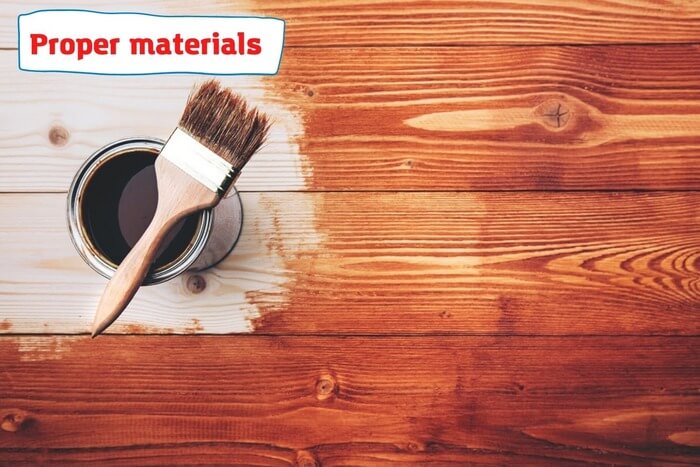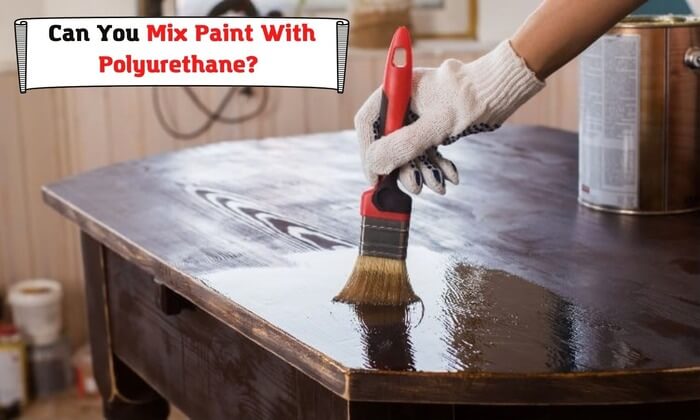
Painting some types of wood may be challenging. For example, pine or cherry may have some tar on it that is hard to remove. Even if you remove the tar that you see now on your wood, it can come out again and this cycle has no end. The amount of tar in wood depends on the tree that has been used to produce this wood. Also, it depends on other numerous factors.
Today we are going to investigate whether you can paint over tar. Not only when working with wood, but also when dealing with tar on the walls or any other surfaces. Sometimes it can be acceptable to just coat the tar stains with paint, but in most cases, we recommend preparing the surface before applying any paint or other coating. Otherwise, you will never be guaranteed that your wood will look good after you spend some hours painting it.
So, here are the main questions we’ll discuss today:
- Painting over tar – when is it acceptable?
- How to prepare the surface for painting over tar?
- When is painting over tar a bad idea?
- What can happen with paint when you apply it over tar?
- What kind of materials should you use for painting?
Let’s get started!
Some cases when you can paint over tar
Some kinds of wood that contain a lot of natural tar aren’t used much in furniture construction or in interior decoration. We tend to use these wood types for fences, technical constructions, frames, etc. In other words, we use this cheaper wood in those places where no one will see them. And in these cases, you can paint over tar without thinking twice.
The main problem when you paint over tar is that the tar spot will change over time. This will tear the paint coats apart and will spoil the way this wood looks. But if no one actually sees it, who cares what it looks like?
Still, some concerns should be taken into account. For example, if the wood is a part of a frame that you want to paint for protecting against pests, moisture, etc., then painting over tar is a bad idea. The tar will destroy the paint and will open the wood for damaging factors. But if the construction is meant to serve for up to 7 or 10 years, this factor can be neglected. You can paint over tar using any appropriate paint type and forget about all precautions.
Also, you can coat the wood with some spots of tar on it using paint if the spots aren’t big at all. The paint will cover them and ensure no contact with oxygen. This should stop the tar from coming out of wood and forming a bigger spot. But this highly depends on what kind of surface we are talking about. If it’s a piece of decoration, better avoid the risks.
Some cases when painting over tar is a bad idea
- You want your wood to look really good and ideal after you apply the final coat of paint or poly on it.
- You want some light paint that can still show the stain of tar under it and spoil the overall design of the surface.
- You need to paint some parts of a future furniture facade that should look perfect to make your furniture more expensive and professional.
- You need the surface to stay ideally even for a long time – painting over tar is a risky thing in this case.
- You want a thin layer of paint with a minimum number of coats.
How to prepare for painting over tar?

Well, it depends on what actually you want to produce. Sometimes it’s enough to just paint the surface with three or four thick coats of paint if you don’t want to spend your time on perfection. But if you are still reading this article, you may want to know more sophisticated ways to deal with those tar stains and make your surface look perfect.
Here are some steps you should follow:
- Scrap off some tar. You will want to clean off as much tar as possible before applying any paint. Be careful – don’t damage the surface because you will need to spend even more time repairing it.
- Use an appropriate cleaning solution to clean the tar off completely. You may use any cleaning products that work well with wood. Use a cloth to wipe it all off and then give it some time to dry.
- You may also sand your wood with 360 to 400 grit sandpaper. This will help you repair any scratches you might have made before and also clean the remains of tar.
- After that use the primer. This will help you hide the stains and prepare the surface for painting. Usually, one coat of primer is enough. But if you see the stains, you may use a second coat. Let it dry according to the instruction given by the producer.
- Paint the surface using at least three coats of paint. You may keep adding coats if the tar stains are still visible after the three coats.
- Let it all dry and harden, then look thoroughly using some additional light to identify any possible visible stains on the surface.
These tips will work well for wood, walls, and also any other surface that is covered with tar and still needs to be painted. The idea is to remove as much tar as possible and then coat it with some primer. After that you may use the paint, you have chosen and enjoy the smooth color.
Be careful when you choose materials because some primers and paint types are transparent enough to show the tar spots to everyone. In this case, even 10 coats of paint won’t save the situation. You will need to clean off all coats and redo the job.
What happens with paint if it’s applied to tar?
Firstly, tar forms an uneven surface that can change over time. The paint you use for covering the surface, won’t be as flexible and may just be destroyed. Also, tar will never harden to the extent it can be a good base for your paint. It will still be soft and will have some moisture in it that can give bad effects.
One more thing to consider is that tar may color your paint. For example, it may make your paint darker in the place of contact. Even if you don’t see any difference in color once you applied the final coat, in one or two months things may change. We have seen guys spending days painting their walls or furniture facades and then finding the dark spots on them.
Painting over tar is a risky thing and you should follow the rules that we’ve given above. If you do, the risks are reduced to minimal thanks to proper preparation.
Proper materials for painting over tar

The choice of paint and primers depends much on the kind of surface you need to cover. It’s hard to give any advice without understanding the current tasks a person has. But we can say that any transparent paint types are really bad for this. If the paint is transparent, it will show all the tar spots after drying. And even if you put on a dozen of coats and spend a couple of days on it, the results will be really poor.
You should choose any paint that can resist water damages. Because sometimes tar contains some moisture and may destroy your paint coats or soak them over time to make the surface look old and shabby rather than smooth and clean.
Any acrylic paint will be OK in contact with tar. This kind of paint is always water-soluble which prevents it from being damaged by water. Thicker paints will be better in this situation than thinner ones. Any oil-based paint is bad in this case because tar can thin it and destroy it right after you apply it or in a month.
Before applying paint on the whole surface, you may test it on a small spot. After testing the paint, you may sand it or clean it with any cleaning solution. But this will help you understand if you are making the right decision. Testing the paint is really important if you need to paint a lot. Any mistake may cost you some days of your time.
Verdict
Painting over tar is not a simple task. Usually, people face painting over tar on a wooden surface and you will have to remember some basic tips for this. If tar is on the walls or on any other surface that doesn’t produce any tar, you will have to clean it to paint afterward. For cleaning tar use acetone or any other cleaning solution that won’t harm the base.
Painting over a thick layer of tar is not the best idea you can come up with. After just a couple of days, your paint may be destroyed, and it’s very hard to achieve the smooth coloring. Usually, the dark spots will still be visible even after you put on the tenth coat of paint.
- Can You Unmix Paint: Techniques, Consequences, Alternatives - February 23, 2024
- Does Primer Need to be Mixed? Effective Primer Application - February 22, 2024
- How to Make Old Paint Usable Again: Retrieving and Preserving Paint - February 21, 2024



